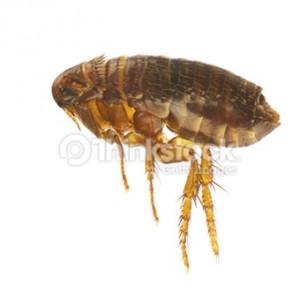by Janet Figarra, DVM
Warm weather is coming and with warm weather comes fleas. The best way to fight these pesky parasites is to know your enemy. Here are some facts to help you understand what you are up against when it comes to protecting against and treating your pet for fleas.
The flea has 4 life stages and each stage allows a different approach for elimination of the parasite.

1) The egg Flea eggs compose 33-50% of the infestation in an average home. Adult fleas lay about 40 eggs each day. These eggs are smooth, round and white. They are lightweight and not sticky. They fall off wherever your pet happens to be. Eggs that land outside in dry, sunny areas are unlikely to survive. Eggs thrive indoors at 65-80 degrees especially in humid environments.
2) Flea larvae Eggs hatch to reveal larvae. Larvae typically comprise up to around 35% of the average infestation. Larvae feed on the flea dirt (feces from the fleas) that falls off of your pet and gathers in your carpet. They go through 3 molts before they spin a cocoon and pupate. Larvae will not survive above 95 degrees. Only 8% of larvae live to pupate. The larval stage can be as short as 9 days.
3) Pupae In the pupal stage, the flea is resistant to environmental changes and can survive temperature extremes that are lethal to larvae. The pupa can remain dormant for months before it is triggered to emerge by vibrations of approaching animals, change in C02 gradient or sound and light patterns. The adult flea emerges hungry and eager to find its first blood meal.
4) The adult flea Once a flea has found a host, it will not leave voluntarily. Females begin laying eggs within 24-48 hours of their first meal and continue until death. The adult lives an average of 4-6 weeks. Average time from egg to adult is 3 weeks.

So how do pets get fleas and what can we do to prevent and treat for them? Some pets come with fleas attached and the infestation does not become apparent until your home is infested as well. Other pets collect obliging fleas from a friend or a neighbor, most commonly from visiting homes with infested carpeting or upholstery. Another option is to buy or rent a home or apartment with fleas included— no extra charge. And how to prevent/treat for fleas? Our pets are the perfect bait for the emerging pupae. Typically we use oral or topical flea treatments and rely on our pets to gather up any unsuspecting flea. The new hitchhiker is exposed to the chosen product on our pet and suffers the consequences.
You can see by the life cycle that effective treatment for fleas must include treatment for eggs and larvae. Many flea products include ‘growth inhibitors’ which prevent eggs from hatching. Lufenuron (found in Sentinel) prevents the developing larvae from making chitin which is needed for the larvae to escape from its egg. Other products contain ‘growth regulators’ such as Methoprene (found in Frontline). Methoprene mimics a youth hormone of fleas; when exposed to this product, eggs and larvae cannot completely mature into adults.
Our staff is quite adept at planning appropriate prevention and treatments for fleas on your pet. Let us know if we can help.
Recent Posts
About Us
Ann Arbor Animal Hospital is a locally-owned animal hospital operating for over 90 years in Ann Arbor, MI.
